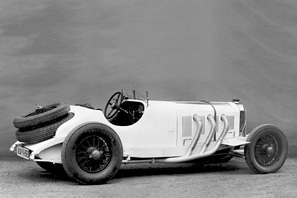The Mercedes-Benz W 06 series, introduced in 1927 with the Type S racing touring car, was subsequently rapidly expanded. Shortly after the Type SS, which was launched in July 1928 and was designed more as a high-performance touring sports car for everyday use than the Type S, the Type SSK was launched, a vehicle that was designed almost exclusively for use in motorsport.
Due to their long wheelbase of 3400 mm, the types S and SS offered extraordinary driving stability, but for certain motorsport competitions such as the hillclimbs that were particularly popular at the time, they lacked manoeuvrability and agility. In order to eliminate this disadvantage, the wheelbase of the well-known Type S chassis was shortened by an impressive 450 mm to 2950 mm in Untertürkheim and the compact racing sports car built on it was named "SSK" - "Super-Sport-Kurz", or "Super-Sport-Short". Since the type SSK was to be entered in both the sports car and racing car classes, the running boards, wings, lamps and soft top could be removed if necessary.
The supercharged six-cylinder engine used in the W 06 series with a displacement of just under 7.1 litres continued to be used as the power unit. As before, the engine block, fitted with wet cylinder liners, was made of the aluminium alloy silumin, while the removable cylinder head was made of grey cast iron. The overhead camshaft was driven by a vertical shaft located at the rear of the engine. At the front of the engine, in contrast to the S and SS models, a more powerful Roots blower with an 18-rib housing was fitted, which increased the maximum output of the six-cylinder engine with compressor to 250 hp/184 kW at 3300 rpm. Without the compressor, the engine's output was now 180 hp/132 kW.
Apart from the shortened wheelbase, the chassis of the SSK had no innovations compared to those of the Types S and SS. In keeping with its clear positioning as a competition car, however, the lower radiator familiar from the Type S was used again - unlike in the Type SS - which allowed for a particularly low silhouette of the bodywork. The shortened wheelbase was also accompanied by a considerable weight saving. While the SS racing touring car weighed in at two tonnes, the SSK was a lightweight with an operating weight of 1520 kg. Its power/weight ratio of around 6 kg/hp gave it excellent performance, with rapid acceleration and a maximum speed of up to just under 200 km/h, depending on the gearing.
The Type SSK made its début just two weeks after the first official start of the Type SS, which had ended with a triumphant triple victory in the German Grand Prix for sports cars at the Nürburgring. Also with Rudolf Caracciola at the wheel, the SSK achieved a persuasive victory with a course record at the renowned Gabelbach hillclimb race near Ilmenau in Thuringia at the end of July 1928.
The idea of making the SSK with its shortened wheelbase an almost unbeatable hillclimb car subsequently proved to be absolutely right: Caracciola took victories in the racing car class at the most important events almost on a weekly basis, for example at the Schauinsland just outside Freiburg, in the Ratisbona hillclimb race near Kelheim, at Mont Ventoux in southern France and at Semmering near Vienna.
These convincing demonstrations of performance prompted those responsible at Daimler-Benz to produce a small series of the Type SSK, originally intended purely as a factory racing car, and by so doing to make it accessible also to talented private drivers. In this way it also entered the sales programme of Daimler-Benz AG - together with the Type SS - from October 1928.
According to official records, a total of 33 cars were produced between 1928 and 1932, a few of them for use outside the world of racing as high-performance touring sports cars with corresponding coachwork created by outside companies.
The majority of the SSKs built, however, had a career as competition cars and, until the end of the 1930s, filled the winners' lists of the sports and racing car classes at a wide variety of motor sport events at home and abroad in droves, piloted by well-known and less well-known drivers. Successes were not only recorded on the mountain, but also in sprint races, in Grand Prix races for sports cars and other circuit races, as well as in road races.
However, the development of the W 06 series did not end with the SSK: the evolution model SSKL (Super Sport Kurz Leicht, or Super Sport Short Light) helped Rudolf Caracciola in 1931 to become the first non-Italian to win overall victory in the "Mille Miglia", the legendary 1000-mile race from Brescia to Rome and back.


